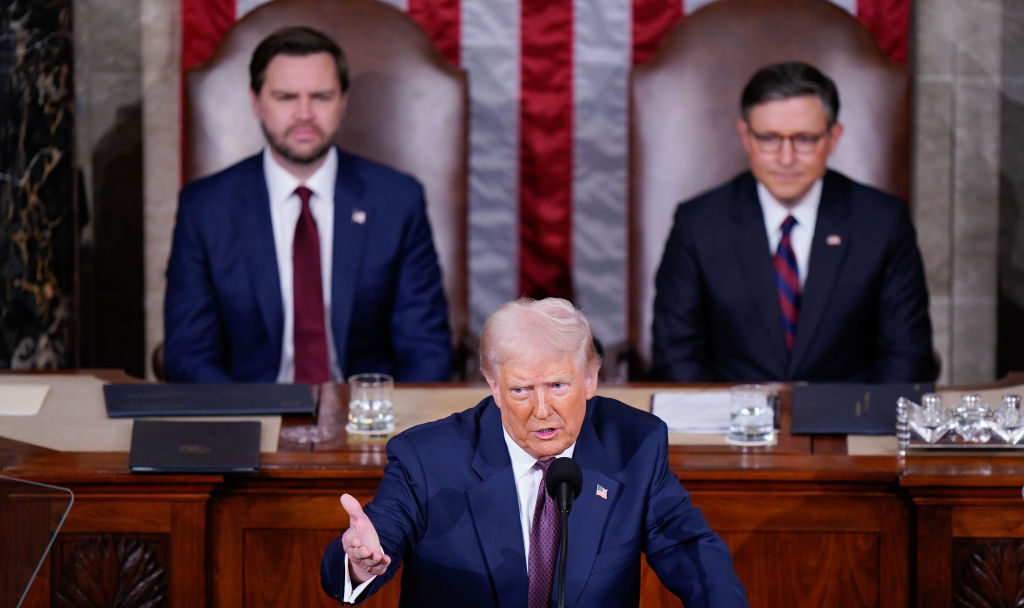
When the Heritage Foundation and its president came out in strong support of President Donald Trump’s tariffs, it was swiftly and widely pointed out that this was at odds with most of the venerable conservative think tank’s 52-year history.
In the run-up to the new tariffs, it was also reported that Trump was willing to contemplate higher taxes on the wealthy to make room for his proposal to exempt tips from income taxes.
On the eve of Trump’s tariffs “Liberation Day,” House Republicans fractured over proxy voting. Many GOP lawmakers have been against the practice on constitutional grounds since the height of the pandemic, and some fear it will look especially bad at the same time they are ordering federal workers back to the office. But the specific question involved proxy voting for new mothers, a bipartisan push spearheaded by a MAGA congresswoman, and some pro-life and pro-family Republicans believed their leadership was on the wrong side of the issue.
The tariffs are happening, at least for a while; the higher tax rates probably aren’t unless Congress fails on the Trump tax cut extension more broadly, and the final outcome on proxy voting for parents is anyone’s guess. But several things are at work here besides Republicans embracing Trump or abandoning Ronald Reagan.
Republicans have different priorities (such as domestic family formation as opposed to maximizing global economic efficiency), a different electoral coalition, and need to find different ways to make free-market economics (with which they have already been making numerous compromises for decades) politically defensible.
When the Reagan tax cuts were initially passed, many ordinary taxpayers paid high marginal tax rates by today’s standards. There were also unlegislated tax increases in the form of “bracket creep,” as inflation pushed families into higher tax brackets. For the highest income earners, the top marginal tax rate was 70 percent. There were more than a dozen tax brackets.
Most of these problems were solved in the 1980s, beginning with the original across-the-board tax cuts. The income tax rate schedule was indexed to inflation in 1985. The tax reform law Reagan signed the following year briefly dropped the number of tax rates to two, with a top marginal rate of 28 percent.
The end result was a tax code that was simpler, more conducive to economic growth—and under attack almost immediately by congressional Democrats from the start of the next (Republican) administration.
It quickly became apparent that Republicans had difficulty winning the political argument on raising the top income tax rate alone, especially when Democrats weren’t proposing to directly and immediately jack it all the way back up to 70 percent. Republican presidents not named George H.W. Bush kept pushing across-the-board tax cuts, which Democrats would resist but would only work to repeal partially once enacted. The economy didn’t exactly tank under Bill Clinton, nor was it booming by the end of George W. Bush’s tenure; while it would be silly on policy grounds to credit or blame the top tax rates at the time for those economic conditions, it does affect the political salience.
No taxes on tips would be a net revenue loser at a time of massive deficits and debt. It wouldn’t have the same Laffer curve effect as a big drop in the top income tax rate. And it would further complicate rather than simplify the tax code. But such a proposal might expand the political constituency for tax cuts and draw voters into the GOP who probably wouldn’t be fussed about whether the top rate is 35 or 39.6 percent.
The same could be argued for the child tax credit, which has much more mainstream Republican support. But it doesn’t reduce marginal tax rates, doesn’t simplify the tax code, and it doesn’t directly incentivize work, savings, or investment in the same way as Republican tax cuts of old.
Subscribe Today
Get daily emails in your inbox
Tariffs are the riskiest of all. They are a tax rather than a tax cut, though Trump vows to use the revenues to cut taxes on American workers and job creators. Many economists dispute whether this can work even in theory, and one needn’t be a free-trade absolutist to acknowledge these tariffs must be implemented with care and a strategic purpose to have a chance of succeeding in practice.
Just as Reagan needed an economic agenda aimed at a different and larger coalition than Tom Dewey’s GOP, Republicans need the same today for a different and developing coalition, regardless of whether anything Trump has proposed so far fits the bill.
Happy Liberation Day to all who celebrate.


